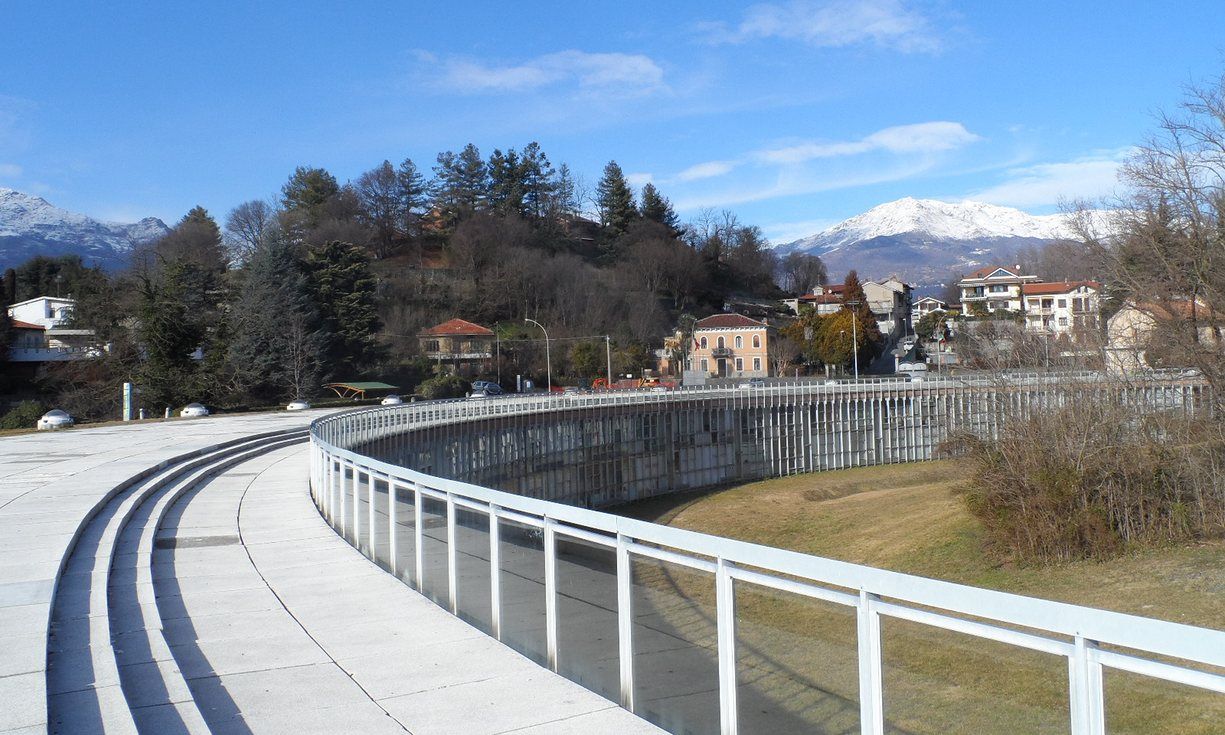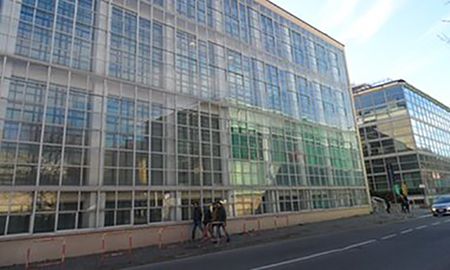In 1933, 32-year-old Adriano Olivetti took over as general manager of the typewriter factory his father had founded outside of the picturesque Italian town of Ivrea, in the foothills of the Alps.
At the time, it was a small family business. But, in the next 30 years under Adriano, the Olivetti company would become a global phenomenon, and Ivrea the focus of ambitious experiments in how to build what he called a more “human” industrial city.
“The street, the factory, the house are the most substantial and visible elements of a civilization in evolution,” Olivetti argued in his book Citta dell’Uomo (City of Man). He complained that Italy’s cities had been expanding “incoherently for uniquely selfish goals, materialistic, speculative, without a real plan coming from a general vision of life”.
Published in January 1960, just weeks before he died, it called for urban development “on a human scale”, with the goal being “harmony between private life and public life, between work and the home, between centers of consumption and centers of production”.
By then Olivetti had become a massive company, with factories in five countries and distribution in more than 100. Best known for its stylish, portable typewriters, beloved by writers from John Updike to Cormac McCarthy, its machines were already considered icons of postwar Italian design.
And Ivrea had been transformed. From a small provincial town it became a major hub of Italian manufacturing, attracting engineers, designers and factory workers from across the country. By the late 1950s there were more than 14,000 people working for Olivetti in Italy, most of whom were in Ivrea. Between the 1930s and 1960s, the town’s population roughly doubled, from around 15,000 to 30,000, with many more in the surrounding areas.
But instead of large tower blocks and grey industrial estates, Ivrea was filled with bright, avant-garde architecture. Hiring some of the country’s leading architects, Olivetti built new neighborhoods for its workers, carefully planned with abundant green space and small blocks of flats with just three or four stories.
New factory buildings were erected almost entirely of glass, because workers inside “had to be able to see the mountains, the valleys, where they come from ... and also so that people outside the factory could see what was happening inside,” explains Beniamino de Liguori, Olivetti’s grandson.
“All the factories and the places of private production were absolutely integrated into the urban fabric of the city,” De Liguori says. He described his grandfather’s goal as nothing less than finding a way “to combine and to harmonize man and machine ... to use technology in a human way, because it was really at the service of man”.
Inside the factories, workers were paid more and conditions were better than at other companies at the time, says Federico Bellono, a representative at the Fiom metalworkers trade union. “Then there was this system of services that was more structured than elsewhere.”
Olivetti’s new factories were designed with in-built space for cafeterias, playgrounds, rooms for debates and film screenings, and libraries with tens of thousands of books and magazines. Outside, an extended network of social services was constructed including nursery schools, Ivrea’s first hospital, and mountaintop retreats for workers’ children.
Olivetti also helped finance the first masterplans for the city and surrounding area. In 1959 a new plan for Ivrea was approved, organizing it into a network of integrated residential areas and proposing a ring road, a new bridge over the river Dora, extensive and decentralized industrial expansion, and the renewal of the historic center.
“From the 1930s until he died in the 1960s … [Olivetti] said that to organise the city you have to plan it,” says Patrizia Bonifazio, professor of urban planning at the Politecnico di Milano. “The factory economically supported the studies and the urban planning proposals, but these were never confined exclusively to the interests of the factory; they always concerned the city in general.”
In the late 19th and early 20th centuries, thousands of small towns and cities across Europe and North America were transformed by industrialization. Along with the archetypal, exploitative “company town”, there were also a number of experiments in more benevolent developments such as Bournville in the UK, near Birmingham, built by the Cadbury family of Quakers as a “model village”.
For Olivetti, urban planning was part of a broader political project. In the late 1940s he founded a new party called Movimento Comunità (Community Movement), and was elected mayor of Ivrea in 1956. Two years later he became a member of parliament in the national government.
He argued that Italian politics should be fundamentally restructured around a federation of relatively autonomous municipalities, or “communities”. The ideal community, he said, would have between 75,000 and 150,000 inhabitants.
“The giant factories, the overcrowded metropolises, the centralized and monolithic states, the mass parties...are without a doubt the leviathans of our time, also destined to disappear to leave room for forms of life that are more agile, more harmonious and, in one word, more human,” Olivetti concluded in Citta dell’Uomo.
After his death, the Olivetti company moved into electronics, producing calculators and some of the world’s first personal computers. And in Ivrea, it continued building.
In 1971, it unveiled one of the city’s more unusual constructions: a housing estate best known locally by its nickname “Talponia” (Moleville) for the fact that it is built almost entirely under a hill, with only one face exposed. From the nearby road the only thing visible is a series of glass domes, poking out of a stretch of land covered with concrete tiles, like futuristic mole hills.
The La Serra complex was also opened – one of the few Olivetti constructions in the city center. An enormous cultural center, it had an auditorium, cinema, hotel and restaurant. Built in steel grey with bright yellow detailing, it was designed to resemble a typewriter, with its hotel rooms in pods that stick out from the building as if they were keys.
Cadigia Perini started working at Olivetti in 1982, in a department that produced user manuals and other documentation for the company’s products. “These were still years of great expansion,” she says, adding, “The city was full, there wasn’t a storage room that was empty.”
Perini lived in the Bellavista neighborhood, built by Olivetti in the 1960s and 70s. “It was incredible...Those areas of Turin and other cities, what are they? Huge blocks of flats one after another. Instead, here the tallest building had three or four floors, there was a lot of green, there were sports fields ... for us it was extraordinary.”
After moving into electronics and computers, in the 1990s the Olivetti company shifted into telecommunications. Over the years it was split into different parts, with branches sold off to new owners; thousands lost their jobs at the company’s factories.
Today, “for sale” signs are ubiquitous in Ivrea. Some of the most iconic buildings commissioned by Olivetti lie empty and abandoned, including most of the La Serra complex. Olivetti is now a small part of the Telecom Italia group, selling tablets and IT services. In 2014, it reported revenues of under 230 million euro (£180m), and said it had just 582 employees.
Most recently, it has been in the news in Italy as more than a dozen former Olivetti managers go on trial over the deaths of former employees, linked to the use of asbestos in the company’s factories. The case is ongoing.
In Ivrea, Perini says the city has not been able to recover from the decline of Olivetti. “By now it’s more than 20 years since the factories closed and the city has not readjusted,” she says.
At the Archivio Storico Olivetti historical archive in Ivrea, Antonio Perazza described Ivrea as “a little city that, with Olivetti, became a pulsing center of industrial activity...and now it’s returned to being a little provincial city”.
Perazza worked for Olivetti in the 1980s, and remembers Ivrea as “a very varied world, very alive, very active culturally”—with his colleagues “coming from all over Italy, but also from all over the world”.
“Unfortunately, in these years, these things have been lost a bit,” he says diplomatically. “Concretely, there has been a return to an antique situation, a situation that there was 70 years ago, when Olivetti was still a small company.”
The UN is now considering granting Ivrea status as a World Heritage Site. In the city’s bid for this status, it described Ivrea between the 1930s and 60s as an “alternative model and unique industrial city based on a social and productive system inspired by ... a way of work, a way of life, in which economic-productive and social spaces existed harmoniously”.
Bonifazio says the bid is an important way for the city to preserve its history. The stories of many innovative cities are “completely unknown, or they have entered into these political and ideological reversals and risk being forgotten forever,” she says.
For Bellono, the Fiom trade unionist, “Industrial models also have to be appraised on their capacity to survive.” Having grown up in Ivrea, he suggests in the case of Olivetti, it was “very centered on ... the person of Adriano Olivetti, and the moment when that reference model disappeared, the cracks began.
“Time tends to turn things into myths: Olivetti’s is as a great industrial but also cultural and social experience,” Bellono says. But, he adds, it was isolated and short-lived, peaking in the 1950s and 60s: “And the heritage ... is unfortunately a territory in crisis.”





